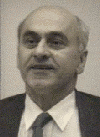
George Richard Isaak, 1933-2005 

Written by Rachel Howe
We are sad to announce that George Isaak died in Birmingham, England on Sunday, June 5th, 2005 after a period of illness.
Born in Poland in 1933, George Isaak moved to Australia as a refugee after WWII. He received his Bachelor's degree from the University of Melbourne in 1955 and a Master's degree at the same institution in 1958. He then spent two years as a physical chemist at ICI, where he first developed the technique of resonant scattering spectroscopy. He moved to the University of Birmingham, England in 1961, first as a research associate and later as a lecturer, gaining his PhD in 1966 under the supervision of P. B. Moon. He was promoted to Senior Lecturer in 1969, to Reader in 1982, and became a Professor of Physics in 1984.
His pioneering work in resonant-scattering spectroscopy led to the first detection (published in 1979) of the solar five-minute oscillation as a global phenomenon in observations of sunlight summed over the whole solar surface. He led the High Resolution Optical Spectroscopy Group at the University of Birmingham, which was the first to operate a world-spanning network of observing sites for helioseismology; under his leadership the group observed simultaneously from Tenerife and Pic du Midi in 1976, first obtained observations from Haleakala and Tenerife in the summer of 1981 and established a six-site global network that was completed in 1991. The BiSON network, as it was later dubbed, is still operating and has produced the longest continuous time series of helioseismic observations.
Although he will be remembered for his contributions to solar seismology, George was also well aware of the importance of stellar seismology, and tireless in his efforts to apply the resonant-scattering techniques to solar-like stars such as Procyon, measuring not only their radial velocities but also their magnetic fields.
He was awarded the Max Born Medal and Prize by the Institute of Physics and the German Physical Society in 1985, the Hughes Medal by the Royal Society (London) in 1993, and the Herschel Medal of the Royal Astronomical Society in 1996.
He was an author on over 150 papers on solar and stellar seismology; the fact that relatively few of them bear his name as first author is a testimony to his generosity and humility, as is the frequent appearance in the acknowledgements -- and sometimes in the author lists -- of the names of technical staff who helped with the work.
Even after his retirement in 1996, George remained actively involved with the BiSON group and also took up an Adjunct Faculty position at the University of Minnesota, carrying out several observing runs at that University's observatory near Tucson, Arizona.
George was a memorable character. Though he spent most of his working life in Birmingham, he retained his Australian citizenship and his distinctive East-European accent. His insightful contributions from the floor at international helioseismology meetings, generally prefaced by 'I have a question and a comment' are still remembered and missed.
George had a contagious enthusiasm for his research that inspired generations of graduate and undergraduate students. His knowledge of, and curiosity about, physics and astrophysics were both deep and wide, leading him to see connections in a way that was often ahead of his time and that made him an exciting and stimulating colleague. From early on, for example, he was fascinated by the possible cosmological implications of helioseismic measurements.
Our sympathies are with his wife, Umit, and two daughters, Katie and Eryka.
Last updated by Thierry
Appourchaux on June 17, 2005